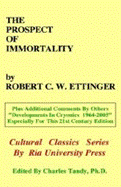
 |
|
|
The Prospect of Immortality
|
Please go to the new Coffee Coaster site implemented more gracefully in Wordpress. This page: http://brianrwright.com/CoffeeCoasterBlog/?p=4577 |

1964, 1966, MacFadden Books, 160 pages
The idea for going back into the time machine, purchasing, and rereading this book was precipitated by the need to get my own contract for cryogenic interment up to date. Shortly after my brother died at the tender age of 56 in May this year, I was contacted by Ben Best of the Cryonics Institute (CI), and encouraged to sit down and draw up the contract, like, now.
Three months later it's done. I even recently attended the CI
annual meeting in Clinton Township, Michigan—where currently 84 patients are stored for eventual revival. Within a few weeks, I'll write a column that covers my resumption of a beautiful relationship with the premier cryogenic research and storage organization in the world.
There aren't too many. The origin for them all is this marvelous book by Dr. Ettinger and his indefatigable efforts to make the "ultimate insurance policy"[1] a fact of life. He has written several other books about life extension and enhancement, including the pioneer transhumanist work, Man into Superman (1972), and more recently Youniverse (2004).
Needless to say, transhumanism and cryonics are still considered "out there" by the vast majority of humankind. "How can you possibly bring back a person's consciousness?" "God never intended people to live past 'three score and ten.'" "Won't this make the population explosion even worse?" "Who wants to come back all old and wrinkled." "I'll be happy to leave this veil of tears."
One hears all manner of rationalizations and just plain misconceptions to accept the status quo. More than 40 years ago (!!) Dr. Ettinger made, still to this day, the most eloquent and passionate appeal to assure a practically immortal future for every commoner who wants one.
Although some of Immortality discusses the potential for life extension and life enhancement in terms of the technology envisioned back in the day, the majority of the book focuses on the technology of "the ultimate insurance policy." Ettinger (b. 1918) recognized he and his contemporary loved ones would surely die before aging and disease would be defeated and rejuvenation achieved; thus the notion of suspended animation—actually one is suspended in a deanimated state—occurred to him as a practical solution.
The initial chapters delve into the mechanics and prospects of successful freezing (I use freezing generally to mean bringing to a temperature of liquid nitrogen (~-200 °C)). Amazing stuff, especially for the early 60s. I was surprised to learn that experimental evidence at the time suggested memory and consciousness can persist after being arrested thru cold temperatures. (For instance, rats retained trained behavior when rewarmed after being cooled to a point for two hours during which no cerebral cortex activity was noted.)
Several sections discuss the issue of freezing and thawing damage, along with expectations of new technology. Indeed, the expectation of new technology drives the optimism of the entire cryonics movement. Other writers such as Ray Kurzweil in Fantastic Voyage: Live long enough to live forever provide solid grounds for such optimism. Kurzweil makes the point that knowledge is not only growing exponentially, the exponent is increasing with time as well! A well known scientist, whose name escapes me, claimed recently that by the end of the 21st century, the average life expectancy of a human being will be 5,000 years!
Judged by that standard, it should become relatively routine to resuscitate, fix, and/or rejuvenate a patient who has been suspended for that purpose. Especially
if care is exercised in preparation for the deep sleep.[2] Also, somewhat ironically, the rapid development of life extension capability obviates much of the need for cryopreservation. (Though I wouldn't be surprised if juvenile delinquents concoct a way to play a form of freeze chicken with the technology. "Hey, y'all, watch this!" :))
Ettinger is a good, flowing writer. Moreover, he has a grasp of the most fundamental issues that can be raised. For example, consider this paragraph under Outer Limits of Optimism:
If we stand back and look at the problem in the broadest outlines, we note that the extreme limits of optimism depend on two questions: 1) Under what circumstances is the identity or the essence of an individual absolutely and forever lost? 2) What limits, if any, will the human race encounter in its technical development, in its ability to manipulate the universe?—page 60.
He makes a few comments on cryonics being consistent with religion, particularly religious injunctions against suicide. Several rather knotty issues are explored, for example, the notion of "mercy freezing."
The book is still rich. My recent congruence with the spiritual enlightenment ideas articulated by Eckhart Tolle—these ideas are consistent with Buddhist impermanence of the form world and transcendence of the inner world of Being—leads me to consider cryonics and life extension in a different light. A poetic one I should wish. And I can think of nothing more poetic than the following passage from The Prospect of Immortality:
Immortality is not an end in itself, nor do we reach for it in blind and breathless panic. It is an opportunity for growth and development otherwise impossible, and it is consistent with our highest current values.—Page 146
Amen.
[1] Briefly the concept of the cryonics movement is individuals who have died intact or who have chosen to deanimate—often due to terminal illness for which there is no current cure—are preserved thru special techniques and stored in radiation-shielded chambers cooled by liquid nitrogen (-196 °C). The contracts are normally funded thru insurance and specify conditions—usually, fix and rejuvenate, "make better than he was"—under which the patient wishes the preserving organization to undertake (no pun intended) to bring him back.
[2] Technically, the suspendee is not sleeping rather in biostasis. All metabolic processes have stopped; when resuscitated the patient will have no sense that any time has passed. Please refer to CI's Website for a full description of cryopreservation procedures.

Click banner to order, click here for book review
 |
||||
| New Pilgrim Chronicles Forum |